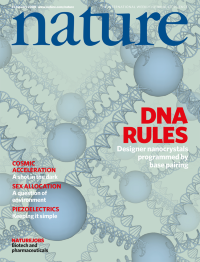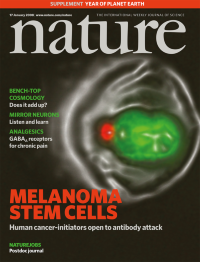Volume 451
-
No. 7182 28 February 2008
After being starved of funds for many years, the efforts of the Gates Foundation and others have raised the stakes in the war against malaria, still a major killer, especially in Africa. This week's Nature looks at the prospects for progress. There is still no vaccine. Brendan Maher explains why, and reports on the push to develop one. Zambia is one of the hardest hit countries and in 2005 launched a plan to cut malaria incidence by 75% by 2008. Michael Hopkin reports on the work of the Malaria Institute at Macha, a centre of excellence established to bolster the national effort and to export expertise to other countries. In a Commentary, epidemiologist Mark Grabowsky stresses the importance of spending the 'new money' in the right way ãâãâãâãâ on surveillance networks for example. Martin Kemp browses the notebooks of Ronald Ross, and finds more than 'just' the discovery linking malaria and the mosquito. See also the Editorial and the online malaria special on http://www.nature.com/news/specials/malaria/index.html.
-
No. 7181 21 February 2008
Understanding how surface water flow could have produced the observed deltas and alluvial fans on the surface of Mars is fundamental to understanding the history of water on the planet. Flow duration in particular is an important factor, but to date, estimates for the longevity of martian hydrologic events have varied erratically, from decades to millions of years. Now, in a series of experiments here on Earth, in the Eurotank facility at Utrecht University, the characteristic morphology of martian stepped or terraced deltas has been recreated. The findings suggest that the stepped fans were formed by sudden release of water from subsurface storage, rather than by surface precipitation. In the conditions prevailing on Mars, this morphology is consistent with a single basin-filling event taking tens of years, and may have required an amount of water comparable to that discharged by a large terrestrial river about the size of the Mississippi. The cover image is a photo composite of a 4 mm-per-pixel digital terrain model of an experimentally formed crater from the Eurotank.
Insight
-
No. 7180 14 February 2008
The Green River formation in Wyoming has produced many important fossils, including Icaronycteris index, which for over 40 years has been regarded as the oldest known bat. Its cranial features suggest that it could locate its insect prey by echolocation. This fuelled a spirited debate between proponents of the 'flight-first', 'echolocation-first' and 'tandem-development' hypotheses of bat evolution. New Green River bat fossils ãâãâEincluding two near-complete skeletons, a cast of one of which is shown on the cover ãâãâElooks to have settled the matter in favour of flight first. The new species is the most primitive bat known. It had fully developed wings and was clearly capable of powered flight, but the morphology of the ear region suggests that it could not echolocate, making it a possible intermediate link between bats and their non-flying, non-echolocating mammalian ancestors. Limb characteristics, including robust hind legs and retention of tiny claws on all of its elongate fingers, indicate that the new bat may have been an agile climber. [Letter p. 818; News & Views p. 774; www.nature.com/podcast] Cover image: American Museum of Natural History.
-
No. 7179 7 February 2008
A new series begins this week. 'Horizons' are commissioned articles in which experts speculate on what will happen over the next few years in their fields. On the cover, one of Antony Gormley's figures in his Another Place installation sets the tone. In the first piece, Thomas Kirkwood considers the potential of systems biology to de-link disease and old age. Peter Murray-Rust writes on a new 'open' approach to chemistry. But his subtext is broader: the future of the 'semantic web', where computers can make as much use of information as humans can. M. Armand and J.-M. Tarascon show how advances in materials science can provide the batteries of the future. George Koentges tackles 'evo-devo', the marriage of fossil evidence, genomic sequencing and molecular developmental biology. And R. J. Schoelkopf and S. M. Girvin raise the prospect that circuit quantum electrodynamics could pave the way for practical quantum computing and communication. On page 643, Nature editor Philip Campbell sets out the brief for these and future Horizons. Cover photo: Andrew Barker/Alamy
-
No. 7178 31 January 2008
The idea that DNA base pairing could direct the crystallization of useful materials is a tempting one for nanotechnologists. Now - over ten years after it was first shown that DNA attached to nanoparticles can influence their assembly - two groups have put this concept into practice. Park et al. demonstrate that the DNA molecules attached to gold nanoparticles, and DNA molecules used to link them, can be selected to ensure that the nanoparticles self-assemble into either face-centred cubic or body-centred cubic crystals. The cover graphic, by Cole Krumbholz, is a close-up of the latter. Nykypanchuk et al. identify the requirements for DNA design and the crystallization conditions that allow the reversible formation of body-centred cubic crystals, with nanoparticles occupying just a few percent of a lattice volume. As discussed in News & Views, these developments might make it possible to create ordered and tunable 3D nanoscale architectures relevant for photonic and magnetic applications, biomedical sensing, and information or energy storage.
-
No. 7177 24 January 2008
To coincide with the flyby of the Pluto-bound New Horizons probe, Jupiter was the target of intensive observation, starting in February 2007, from a battery of ground-based telescopes and the Hubble Space Telescope (HST). Weeks into the project, on 25 March, an intense disturbance developed in Jupiter's strongest jet at 23° North latitude, lasting to June 2007. This type of event is rare the last ones were seen in 1990 and 1975. The onset of the disturbance was captured by the HST, and the development of two plumes was followed in unprecedented detail. The two plumes (bright white spots in the small infrared image on the cover) towered 30 km above the surrounding clouds. The nature of the power source for the jets that dominate the atmospheres of Jupiter and Saturn is a controversial matter, complicated by the interplay of local and planet-wide meteorological factors. The new observations are consistent with a wind extending deep into the atmosphere, well below the level reached by solar radiation. In the larger cover image, turbulence caused by the plumes can be seen in the band that is home to the jet.









